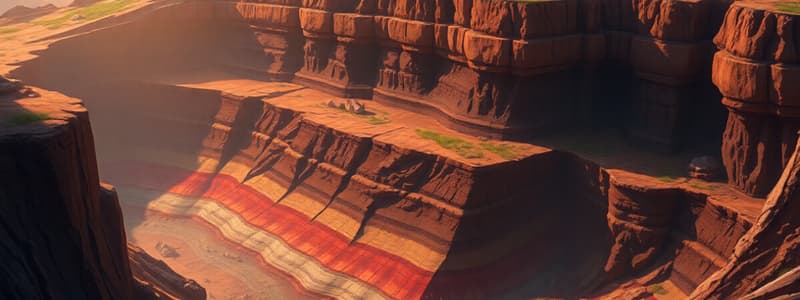Podcast
Questions and Answers
Which layer of the Earth is primarily composed of lighter materials such as silicon and aluminum?
Which layer of the Earth is primarily composed of lighter materials such as silicon and aluminum?
- Mantle
- Inner Core
- Outer Core
- Crust (correct)
Which layer allows the lithospheric plates to move over it?
Which layer allows the lithospheric plates to move over it?
- Asthenosphere (correct)
- Outer Core
- Mesosphere
- Inner Core
What is the main composition of the Earth's inner core?
What is the main composition of the Earth's inner core?
- Liquid iron and nickel
- Solid iron and nickel (correct)
- Basaltic and granitic rocks
- Silicate minerals rich in aluminum
What best describes the properties of the mesosphere?
What best describes the properties of the mesosphere?
Which mechanical layer is described as liquid and generates the Earth's magnetic field?
Which mechanical layer is described as liquid and generates the Earth's magnetic field?
What is the primary characteristic of the continental crust compared to oceanic crust?
What is the primary characteristic of the continental crust compared to oceanic crust?
Which layer of the Earth is considered to be part of the lithosphere?
Which layer of the Earth is considered to be part of the lithosphere?
What distinguishes the asthenosphere from the lithosphere?
What distinguishes the asthenosphere from the lithosphere?
Which of the following correctly describes the location of the outer core?
Which of the following correctly describes the location of the outer core?
What is the primary reason the inner core remains solid despite its high temperature?
What is the primary reason the inner core remains solid despite its high temperature?
Which characteristic is true for the mesosphere compared to the asthenosphere?
Which characteristic is true for the mesosphere compared to the asthenosphere?
Which materials primarily make up the Earth’s outer core?
Which materials primarily make up the Earth’s outer core?
What role does the movement of the outer core play for the Earth?
What role does the movement of the outer core play for the Earth?
What primarily distinguishes the composition of the mantle from that of the crust?
What primarily distinguishes the composition of the mantle from that of the crust?
Flashcards are hidden until you start studying
Study Notes
Compositional Layers
-
Crust: Outermost layer composed of light materials such as silicon, oxygen, and aluminum; made up of continental and oceanic crust types.
- Continental Crust: Thicker, primarily granitic rock formation.
- Oceanic Crust: Thinner, primarily basaltic rock formation.
-
Mantle: Located beneath the crust, extends to approximately 2,900 km deep, composed of denser silicate minerals that are rich in iron and magnesium.
-
Core: Innermost layer, ranging from about 2,900 km deep to the Earth's center, primarily composed of iron and nickel.
Mechanical Layers
-
Lithosphere: Comprised of the crust and the upper mantle; characterized as rigid and solid, divided into tectonic plates that shift on the surface.
-
Asthenosphere: Located below the lithosphere in the upper mantle; it is soft and capable of slow flow, facilitating the movement of lithospheric plates.
-
Mesosphere: Found below the asthenosphere, extends through the lower mantle; more solid and rigid than the asthenosphere but maintains the ability for very slow flow.
-
Outer Core: Positioned beneath the mesosphere, surrounding the inner core; consists of liquid iron and nickel, the movement of which generates the Earth’s magnetic field.
-
Inner Core: The central part of the Earth; solid and extremely hot, made primarily of iron and nickel, remains solid due to the immense pressure, despite high temperatures.
Compositional Layers
-
Crust: Outermost layer composed of light materials such as silicon, oxygen, and aluminum; made up of continental and oceanic crust types.
- Continental Crust: Thicker, primarily granitic rock formation.
- Oceanic Crust: Thinner, primarily basaltic rock formation.
-
Mantle: Located beneath the crust, extends to approximately 2,900 km deep, composed of denser silicate minerals that are rich in iron and magnesium.
-
Core: Innermost layer, ranging from about 2,900 km deep to the Earth's center, primarily composed of iron and nickel.
Mechanical Layers
-
Lithosphere: Comprised of the crust and the upper mantle; characterized as rigid and solid, divided into tectonic plates that shift on the surface.
-
Asthenosphere: Located below the lithosphere in the upper mantle; it is soft and capable of slow flow, facilitating the movement of lithospheric plates.
-
Mesosphere: Found below the asthenosphere, extends through the lower mantle; more solid and rigid than the asthenosphere but maintains the ability for very slow flow.
-
Outer Core: Positioned beneath the mesosphere, surrounding the inner core; consists of liquid iron and nickel, the movement of which generates the Earth’s magnetic field.
-
Inner Core: The central part of the Earth; solid and extremely hot, made primarily of iron and nickel, remains solid due to the immense pressure, despite high temperatures.
Studying That Suits You
Use AI to generate personalized quizzes and flashcards to suit your learning preferences.




